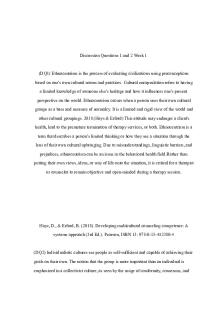WEEK1 Accomplish PDF

| Title | WEEK1 Accomplish |
|---|---|
| Course | Policing |
| Institution | University of the Cumberlands |
| Pages | 3 |
| File Size | 59.6 KB |
| File Type | |
| Total Downloads | 32 |
| Total Views | 211 |
Summary
w1 Accomplish online course...
Description
1 Olivia Verdecchia Policing October 27th, 2019
The first theory that is stated in our textbook is the disorder-control theory. This explains the development to suppress mob violence. This theory is also used to control mob violence of any sort. Mob violence is something that we don’t see as frequently today as it was seen in the 1800s. I believe that this is because there is just not as much mob activity in our world today. The second theory that is listed is the crime-control theory. According to Novak, the crime-control theory suggests that “increases in criminal activity resulted in a perceived need for a new type of police” (2017, p.36). The types of crimes that increase can be anywhere from threats to our communities, social order, and more. These types of crimes create fear in our communities, which is why a need for new kinds of policing is needed. I believe that this theory is one that is very important in shaping our police departments in the United States today. I think that crime-control is something that is needed in every community and since that is the focus of this theory it is vital. The third theory that is listed is the class-control theory. This theory is based on the development of police as a result of class-based exploitation. This theory advocates that urban and industrial growth coincides with the development of new police (Novak, 2017, p.36). People from different ethnic backgrounds were looking for various opportunities to improve their economic status. This created lots of disruption in the middle and upper classes because the poorer classes were the ones trying to improve their status. This theory states that modern police forces were only being used as a tool that was created by the elite to suppress those being fueled by capitalism.
2 The last theory that is mentioned is the urban-dispersion theory. This theory “holds that many municipal police departments were created because other cities had them, not because there was a real need” (Novak, 2017, p.36). I think this is an odd reasoning to create police departments. I feel that if there is not a need for them, you should be able to save money by not creating more than you need to. However, I think that in today's world it is crucial that we have all the different police departments that we currently do. Novak states in the text that police forces were created because they were an integral part of the governmental structure that was needed to provide stabilization and influence on our communities (2017, p.36). Overall, I think that all four of the theories that are stated in our textbook have provided some support and reasoning as to why our police departments are the way they are today. Not one of the theories is responsible for the way our departments are today, but I feel that the urbandispersion theory has had the most significant impact overall. I think this is because our society is easily influenced by what is going on around us. Because more police departments were created because other cities had them, there is now an overwhelming number of departments out there that can help our communities. I think that in the United States it is essential that we have more of what we need to control crime rather than lacking in aspects that could eventually cause harm to our communities and all the people living in them. As Novak states in the text “No single theory provides an adequate explanation. (2017, p. 36). However, I believe that the urbandispersion theory best explains the development of our police forces in the United States today.
3 References Novak, K., Cordner, G., Roberg, R., & Smith, B. (2017). Police & Society (7th ). New York, NY: Oxford University Press....
Similar Free PDFs

WEEK1 Accomplish
- 3 Pages

Week1 Regression
- 114 Pages

Information Security-Week1 Notes
- 5 Pages

Handout-1 - week1
- 2 Pages

Week1 programming challenges
- 26 Pages

Week1 notes - ECON 3640
- 8 Pages

Week1 Lecture 1 1perpage
- 31 Pages

CS2200 Mid1 - week1-5
- 27 Pages

Discussion Questions Week1
- 2 Pages

WEEK1 Session 2 NSV
- 20 Pages

WEEK1 ATI CHPS Advanced
- 12 Pages

PROG 3114 Week1-10
- 16 Pages

History week1 responses
- 2 Pages

Relativity Notes 2015-Week1
- 6 Pages

BST Week1 Assignment 2
- 4 Pages

ITECH2000-week1-12 Question
- 51 Pages
Popular Institutions
- Tinajero National High School - Annex
- Politeknik Caltex Riau
- Yokohama City University
- SGT University
- University of Al-Qadisiyah
- Divine Word College of Vigan
- Techniek College Rotterdam
- Universidade de Santiago
- Universiti Teknologi MARA Cawangan Johor Kampus Pasir Gudang
- Poltekkes Kemenkes Yogyakarta
- Baguio City National High School
- Colegio san marcos
- preparatoria uno
- Centro de Bachillerato Tecnológico Industrial y de Servicios No. 107
- Dalian Maritime University
- Quang Trung Secondary School
- Colegio Tecnológico en Informática
- Corporación Regional de Educación Superior
- Grupo CEDVA
- Dar Al Uloom University
- Centro de Estudios Preuniversitarios de la Universidad Nacional de Ingeniería
- 上智大学
- Aakash International School, Nuna Majara
- San Felipe Neri Catholic School
- Kang Chiao International School - New Taipei City
- Misamis Occidental National High School
- Institución Educativa Escuela Normal Juan Ladrilleros
- Kolehiyo ng Pantukan
- Batanes State College
- Instituto Continental
- Sekolah Menengah Kejuruan Kesehatan Kaltara (Tarakan)
- Colegio de La Inmaculada Concepcion - Cebu